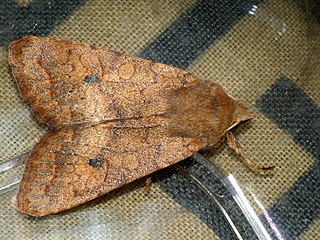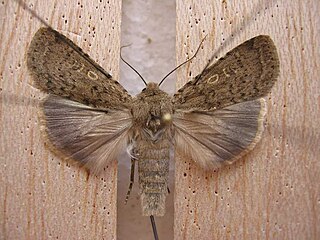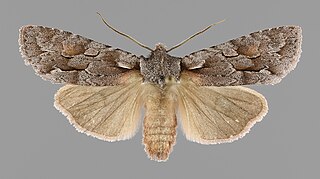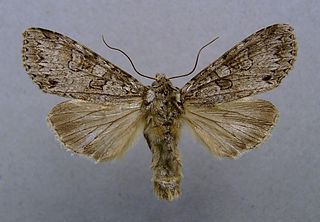
The broad-barred white is a moth of the family Noctuidae. The species was first described by Johann Siegfried Hufnagel in 1766. It is distributed throughout Europe and is also found in Turkey, Iran, Israel, Lebanon, Syria, Kirghizia, Tajikistan, western Siberia and China.

Agrochola circellaris, or The Brick, is a species of moth of the family Noctuidae. The species was first described by Johann Siegfried Hufnagel in 1766. It is distributed throughout most of Europe, Asia Minor and Armenia.

The straw underwing is a species of moth in the family Noctuidae. The species was first described by Johann Siegfried Hufnagel in 1766. It is found from North Africa west through South Europe and Central Europe. In the north it is in parts of Ireland, Scotland, Sweden, Norway, Finland and Estonia. Further east the range stretches from southern Russia and Asia minor to the Caucasus.

Apamea monoglypha, the dark arches, is a moth of the family Noctuidae. The species was first described by Johann Siegfried Hufnagel in 1766. It is a common, sometimes abundant, European species. It is found in most of Europe except northernmost Fennoscandia and the southern parts of the Iberian Peninsula and Greece. The species is also found in Anatolia, Turkestan, Western Asia and Central Asia, Siberia and Mongolia. In the Alps it is found up to heights of 2,500 meters. The smaller subspecies sardoa is found on Sardinia and Corsica.

Apamea sordens, the rustic shoulder-knot or bordered apamea, is a moth of the family Noctuidae. The species was first described by Johann Siegfried Hufnagel in 1766. It is distributed throughout Europe, east across the Palearctic to Central Asia and to China and Japan. It also occurs in North America.

Lithophane leautieri, the Blair's shoulder-knot, is a moth of the family Noctuidae. It is found in Europe. It originated from the area surrounding the Mediterranean Sea, but gradually moved north.

Pyrrhia umbra, the bordered sallow, is a moth of the family Noctuidae. The species was first described by Johann Siegfried Hufnagel in 1766. It is found in all of Europe, east through Anatolia to Iran, Afghanistan, Pakistan and Nepal and through central Asia to Japan. In mountains it can be found up to elevations of 1,600 meters.

Euxoa obelisca, the square-spot dart, is a moth of the family Noctuidae. It is found in the Palearctic realm.

Lithophane semibrunnea, the tawny pinion, is a moth of the Noctuoidea family. It is found in scattered populations in North Africa, central and southern Europe and Asia Minor.

Pachetra is a monotypic moth genus of the family Noctuidae erected by Achille Guenée in 1841. Its only species, Pachetra sagittigera, the feathered ear, was first described by Johann Siegfried Hufnagel in 1766. It is found in central and southern Europe, east to the Ural, north to southern England, Sweden and Finland. Southwards it is found from Anatolia, central Asia and the Altai up to Mongolia. It is also present in North Africa.

Agrotis vestigialis, the archer's dart, is a moth of the family Noctuidae. The species was first described by Johann Siegfried Hufnagel in 1766. It is found in most of the Palearctic realm from Ireland east, through to Russia, Siberia, the Altai Mountains and the Amur region, and is also present in the Mediterranean Basin. It is absent from the north of Finland and Norway.

Rhyacia simulans, the dotted rustic, is a moth of the family Noctuidae. The species was first described by Johann Siegfried Hufnagel in 1766. It is found in most of Europe, south to Morocco, Algeria and Tunisia, east to Turkey, the Caucasus, Tomsk and Minusinsk.

Lithophane socia, the pale pinion, is a moth of the family Noctuidae. The species was first described by Johann Siegfried Hufnagel in 1766. It is found throughout western Europe from Spain to central Scandinavia then east across the Palearctic to Siberia, the Russian Far East and Japan.

Chilodes maritimus, the silky wainscot, is a moth of the family Noctuidae. It is found in most of Europe including Russia.

Apamea oblonga, the crescent striped, is a moth of the family Noctuidae. The species was first described by Adrian Hardy Haworth in 1809. It is found in northern and central Europe, east to southern Russia, Asia Minor, Armenia, Turkestan, Turkey, Iran, southern Siberia, northern Pakistan, Mongolia, China, Sakhalin and Japan

Lithophane consocia, the scarce conformist or Softly's shoulder-knot, is a moth of the family Noctuidae. The species was first described by Moritz Balthasar Borkhausen in 1792. It is found throughout northern, central and eastern Europe, east to Siberia. There is a single record from Great Britain, where it was recorded in Hampstead, London, in September 2001.

Lithophane lamda, the nonconformist, is a moth of the family Noctuidae. It is found throughout Europe, except in southern Europe. It is also absent from Iceland and Ireland.

Polia nebulosa, the grey arches, is a moth of the family Noctuidae. The species was first described by Johann Siegfried Hufnagel in 1766. It is found in temperate Europe and Asia up to eastern Asia and Japan. It is not present in northernmost Fennoscandia and the southern parts of the Iberian Peninsula, Italy and Greece. In the Alps it is found at heights up to 1,600 meters.

Lithophane furcifera, the conformist, is a moth of the family Noctuidae. The species was first described by Johann Siegfried Hufnagel in 1766. It is found from central Europe, east to the Black Sea region, the Caucasus and western Siberia. In the mountains, it is found up to elevations of 1,800 meters.

Archanara neurica, the white-mantled wainscot, is a nocturnal moth of the family Noctuidae described by Jacob Hübner in 1808. It is found in Austria, Belgium, Bosnia and Herzegovina, Great Britain, Bulgaria, Croatia, the Czech Republic, Denmark, France, Germany, Hungary, Italy, Latvia, Liechtenstein, North Macedonia, Poland, Romania, Sicily, Slovakia, Slovenia, Switzerland, the Netherlands and Serbia. In the UK, its only regular sites are at RSPB Minsmere and Walberswick National Nature Reserve in Suffolk.






















